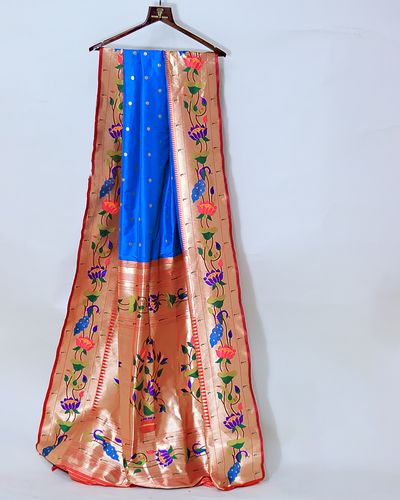Comparing Pure Silk Paithani Sarees vs. Semi-Silk Alternatives

Pure Silk Paithani Sarees vs. Semi-Silk Paithani Saree
Paithani sarees are cherished for their intricate craftsmanship, luxurious feel, and vibrant motifs. However, not all Paithani sarees are created equal, with differences in fabric composition being a key distinguishing factor. Here's a detailed comparison between pure silk Paithani sarees and semi-silk alternatives to help you make an informed choice.
1. Fabric Composition
-
Pure Silk Paithani:
-
Made entirely of high-quality mulberry silk for both the warp and weft.
-
Known for its natural sheen, smooth texture, and rich feel.
-
Semi-Silk Paithani:
-
Combines silk with other materials like cotton or art silk.
-
Offers a silk-like appearance but lacks the authentic feel and quality of pure silk.
2. Appearance and Texture
-
Pure Silk Paithani:
-
Lustrous and vibrant, with a soft and luxurious drape.
-
The saree has a natural shimmer that reflects light beautifully.
-
Semi-Silk Paithani:
-
Looks similar to pure silk but has a slightly coarser texture.
-
The shine is often synthetic, making it appear less elegant than pure silk.
3. Weight and Comfort
-
Pure Silk Paithani:
-
Heavier due to the dense silk threads and zari work.
-
Feels soft and comfortable on the skin, ideal for long hours of wear.
-
Semi-Silk Paithani:
-
Lighter in weight, making it easier to carry, especially for casual occasions.
-
May not be as soft as pure silk, depending on the material blend.
4. Durability
-
Pure Silk Paithani:
-
Highly durable and long-lasting with proper care.
-
Maintains its beauty and quality over decades, making it an heirloom-worthy piece.
-
Semi-Silk Paithani:
-
Less durable due to the mixed fabric composition.
-
Prone to wear and tear over time, especially if not handled carefully.
5. Price
-
Pure Silk Paithani:
-
Expensive, reflecting the premium materials and intricate craftsmanship.
-
Prices start at ₹20,000 and can go up to several lakhs, depending on the design and zari work.
-
Semi-Silk Paithani:
-
Budget-friendly alternative, often priced between ₹5,000 and ₹15,000.
-
Suitable for those seeking the Paithani look at an affordable price.
6. Zari Quality
-
Pure Silk Paithani:
-
Uses genuine gold or silver-coated zari threads.
-
The zari work is intricate and adds a regal touch to the saree.
-
Semi-Silk Paithani:
-
Often uses synthetic or metallic zari, which lacks the richness of real zari.
-
The designs may appear less refined compared to pure silk Paithanis.
7. Occasion Suitability
-
Pure Silk Paithani:
-
Perfect for weddings, festivals, and grand occasions.
-
Its opulence makes it a standout choice for brides and traditional celebrations.
-
Semi-Silk Paithani:
-
Suitable for casual gatherings, smaller events, or as a lighter alternative for daily wear.
-
Ideal for those who want a Paithani look without the formality.
8. Care and Maintenance
-
Pure Silk Paithani:
-
Requires careful handling and professional dry cleaning.
-
Needs to be stored properly, folded with soft cloth to prevent zari tarnishing.
-
Semi-Silk Paithani:
-
Easier to maintain and can often be hand-washed.
-
Requires less delicate handling, making it more practical for regular use.
The choice between pure silk and semi-silk Paithani sarees depends on your priorities:
-
Choose Pure Silk: If you value authenticity, durability, and luxury, or if you’re buying for special occasions or as an heirloom.
-
Choose Semi-Silk: If you’re looking for affordability, ease of wear, and a stylish alternative for casual or less formal events.
Both options have their own charm, but pure silk Paithanis remain unmatched in their richness, making them the ultimate choice for those seeking timeless elegance.
